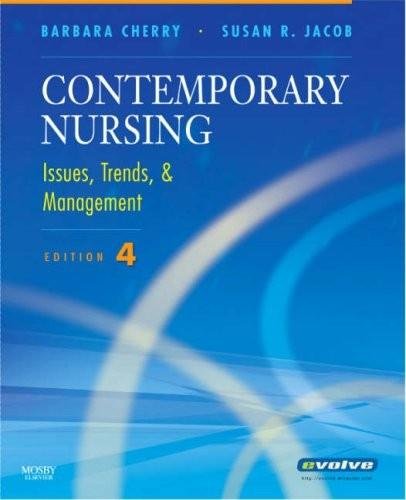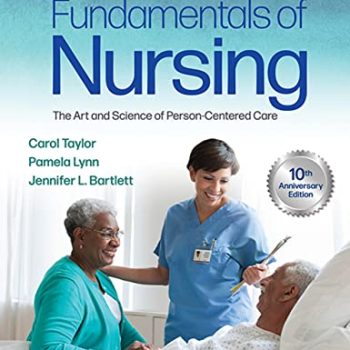Contemporary Nursing Issues Trends And Management 4th Edition By Jacob -Test Bank
Chapter 1: The Evolution of Professional Nursing
MULTIPLE CHOICE
1.Clara Barton is known for
|
A. |
becoming the first African-American public health nurse. |
|
B. |
establishing the Henry Street Settlement. |
|
C. |
founding the American Red Cross. |
|
D. |
publicizing the inadequacies of hospital-based nursing schools. |
ANS: C
(C) is correct because the American Red Cross, founded by Clara Barton in 1882, assisted in efforts to continue public health nursing. (A) is incorrect because Jessie Sleet Scales was the first African-American public health nurse. (B) is incorrect because Lillian Wald, a pioneer in public health nursing, is best known for the development and establishment of the Henry Street Settlement. (D) is incorrect because The Goldmark Report criticized the inadequacies of hospital-based nursing schools and recommended enhanced educational standards.
DIF: Knowledge REF: Page 16
2.Which bill provided for construction of hospitals?
|
A. |
Social Security Act |
|
B. |
Hill-Burton Act |
|
C. |
Sheppard-Towner Act |
|
D. |
U.S. Civil Service Act |
ANS: B
(B) is correct because the purpose of the Hill-Burton Act was to provide funding to construct hospitals and to assist states in planning for other health care facilities in accordance with the needs of communities. (A) is incorrect because the main purposes of the 1935 Social Security Act were to provide (1) a national insurance system for the elderly; (2) monies to states for maternal and child welfare services; (3) vocational rehabilitation services for the physically and mentally challenged; (4) medical care for crippled children and blind people; (5) a plan to boost public health services; and (6) a federal/state unemployment system. (C) is incorrect because the Sheppard-Towner Act provided federal aid for maternal and child health care. (D) is incorrect because the U.S. Civil Service Act is landmark U.S. legislation establishing the tradition and mechanism of permanent federal employment based on merit rather than on political party affiliation (the spoils system).
DIF: Knowledge REF: Page 18
3.The practice of public health nursing and the Henry Street Settlement are credited to
|
A. |
Mary Breckenridge. |
|
B. |
Mary Seacole. |
|
C. |
Clara Barton. |
|
D. |
Lillian Wald. |
ANS: D
(D) is correct because Lillian Wald was a pioneer in public health nursing who is best known for the development and establishment of the Henry Street Settlement. (A) is incorrect because Mary Breckenridge of Kentucky established the Frontier Nursing Service in 1925. (B) is incorrect because Mary Seacole was a black nurse who provided care during the Crimean War. (C) is incorrect because Clara Barton founded the American Red Cross in 1882.
DIF: Knowledge REF: Page 15
4.Occupational health nursing features beliefs similar to those of which early nursing pioneer?
|
A. |
Lillian Wald |
|
B. |
Florence Nightingale |
|
C. |
Clara Barton |
|
D. |
Mary Seacole |
ANS: A
(A) is correct because Lillian Wald developed the first nursing service for occupational health. (B) is incorrect because Florence Nightingale is best known for contributions made during the Crimean War, efforts to improve sanitation and public health, use of statistics to provide support for health outcomes, and organization of nurse training. (C) is incorrect because Clara Barton founded the American Red Cross. (D) is incorrect because Mary Seacole was a black nurse who served during the Crimean War.
DIF: Comprehension REF: Page 14
5.What historical event first led to the realization of the contribution of African-Americans to nursing?
|
A. |
Florence Nightingale’s acceptance of African-American nurses into the first nursing school |
|
B. |
The contributions of African-American nurses at the Pennsylvania Hospital, the first hospital in America |
|
C. |
Mary Seacole’s efforts to care for soldiers during the Crimean War |
|
D. |
The wives of wealthy African-American nobles who carried food and medicine from house to house during the Middle Ages |
ANS: C
(C) is correct because although Nightingale’s school refused Seacole, she was able to make a difference in the Crimean War and later was recognized for her efforts. (A) is incorrect because Florence Nightingale’s efforts during the Crimean War were valuable and recognized, but she would not allow Seacole to join her in her efforts. (B) is incorrect because Pennsylvania Hospital was the first hospital in America and was founded in 1751, but Seacole’s efforts in the Crimean War did not occur until 100 years later. (D) is incorrect because the wives of noblemen who carried food and medicine were not uniquely African-Americans.
DIF: Application REF: Page 12
6.World War I contributed to the advancement of health care by
|
A. |
increasing the number of private care hospitals and decreasing the role of public health services. |
|
B. |
employing a large number of civilians to provide care to returning soldiers through the Red Cross. |
|
C. |
introducing specialists in nursing such as nurse anesthetists. |
|
D. |
increasing the number of community health nurses. |
ANS: C
(C) is correct because World War I offered nurses a chance to enter into new fields of specialization, as is seen in the example of nurse anesthetists who became part of surgical teams at the front lines. (A) is incorrect because advancements in public health were being made and the primary site for medical care was moved from the home to the hospital. (B) is incorrect because the Red Cross provided care to communities in which access was limited and eventually moved to urban areas. (D) is incorrect because many nurses were needed in the war effort, which caused the growth in community health nursing to halt.
DIF: Application REF: Page 15
7.The primary purpose of the Social Security Act of 1935 was to
|
A. |
increase research that focused on minority groups. |
|
B. |
provide medical care for chemically impaired persons. |
|
C. |
ensure health care for older adults through a national insurance system. |
|
D. |
decrease the public’s financial burden by limiting services offered by local health departments. |
ANS: C
(C) is correct because the Social Security Act of 1935 set the precedent for the passage of the Medicare and Medicaid acts that followed in 1965 to provide health insurance for the elderly, but it also provided maternal and child welfare services, along with rehabilitation for the mentally and physically challenged, medical care for blind individuals and crippled children, and unemployment benefits. (A) is incorrect because increasing research for minorities was not one of the purposes of the Social Security Act of 1935. (B) is incorrect because the care of persons with substance abuse problems was not one of the first purposes addressed by the Social Security Act. (D) is incorrect because the Social Security Act provided a means by which women and children could receive care, thus increasing the numbers of public health nurses and services offered.
DIF: Comprehension REF: Page 19
8.A patient asks the nurse, “I received information on getting help paying for my hospitalization. Can you explain Medicare, an amendment to the Social Security Act?” The nurse responds that Medicare
|
A. |
led to many hospital closings, along with a decrease in acute care hospital–based nursing care. |
|
B. |
provided medical insurance to those younger adults or children who were not eligible for private insurance because of catastrophic illnesses such as cancer. |
|
C. |
provided preventive care for women, infants, and children. |
|
D. |
ensured that individuals with end-stage renal disease had health care insurance. |
ANS: D
(D) is correct because the Medicare program provides hospital insurance, Part A, and medical insurance, Part B, to all people age 65 and older who are eligible to receive Social Security benefits; people with total, permanent disabilities; and people with end-stage renal disease. (A) is incorrect because Medicare provides insurance for many who previously have not sought health care, resulting in an increase, not a decrease, in hospital care. (B) is incorrect because medical insurance for young adults and children who were not eligible for private insurance is part of Medicaid. (C) is incorrect because Medicaid was the medical insurance for those families, primarily women and children, with an income at or below the federal poverty level.
DIF: Comprehension REF: Page 19
9.A comparison of nursing in the 1980s versus nursing in the 1990s reveals that
|
A. |
the 1990s influenced nursing in that a reduction occurred in preventable diseases caused by unsafe/unhealthy lifestyles. |
|
B. |
tuberculosis was the primary concern for nursing in the 1980s, whereas the AIDS epidemic emerged and was its focus during the 1990s. |
|
C. |
a decrease in ambulatory services in the 1980s prompted an increase in public health nurses in the 1990s. |
|
D. |
the demand for advanced practice nurses increased in the 1980s and the 1990s as a result of the economy and concern about the health of the nation. |
ANS: D
(D) is correct because the numbers of advanced nurse practitioners increased as evidence of their cost-effectiveness as providers of primary and preventive health care became established. (A) is incorrect because in the 1990s, many diseases associated with preventable causes led to mortality in the United States. (B) is incorrect because the AIDS epidemic appeared in the 1980s and tuberculosis became more of a concern in the 1990s. (C) is incorrect because the 1980s saw an increase in technology that allowed more outpatient procedures, increased use of ambulatory services, and increased demand for community health nurses.in the 1990s.
DIF: Application REF: Page 23
10.Which of the following statements accurately describes the historical perspective of nursing practice?
|
A. |
Nursing has existed to meet the needs of populations, individuals, and aggregates by providing care that is influenced by the needs and beliefs of society in different historical contexts. |
|
B. |
When men became interested in nursing, this provided the impetus to change nursing into a respected profession based on scientific fact rather than superstition. |
|
C. |
Nursing has historically accepted individuals from all social and ethnic backgrounds. |
|
D. |
The United States has led the way throughout history to advance nursing and health care by providing the first hospital and medical school. |
ANS: A
(A) is correct because nursing has existed since biblical times to address needs ranging from contagious diseases in early times to health prevention in the present time, with care based on health beliefs of the time. (B) is incorrect because in the beginning, men were recognized as health healers, but women changed nursing from a mystical phenomenon to a respected profession. (C) is incorrect because nursing, has had periods where criminals and prostitutes practiced and discrimination was evidenced by Nightingale’s refusal of Seacole. (D) is incorrect because the first hospital and the first medical school in North America were founded in Mexico—the Hospital of the Immaculate Conception in Mexico City and the University of Mexico Medical School.
DIF: Application REF: Pages 10-25









Reviews
There are no reviews yet.